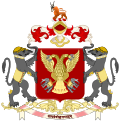| Maharaja of Mysore | |
|---|---|
 Royal coat of arms (1893) | |
| Details | |
| Style | His Highness |
| First monarch | Yaduraya Wodeyar |
| Last monarch | Jayachamaraja Wodeyar |
| Formation | 1399 |
| Abolition | 26 January 1950 |
| Residence | Mysore Palace |
The maharaja of Mysore was the king and principal ruler of the Kingdom of Mysore and briefly of Mysore State in the Indian Dominion roughly between the mid- to late-1300s and 1950. The maharaja's consort was called the maharani of Mysore.
In title, the role has been known by different names over time, from poleygar (Kannada, pāLegāra, for 'chieftain'[1][2]) during the early days of the fiefdom to raja (Sanskrit and Kannada, king–of especially a small region) during its early days as a kingdom to maharaja (Sanskrit and Kannada, [great] king–of a formidable kingdom[3]) for the rest of its period. In terms of succession, the successor was either a hereditary inheritor or, in case of no issue, handpicked by the reigning monarch or his privy council. All rulers under the Sanskrit-Kannada titles of raja or maharaja were exclusively from the house of Wadiyar.
As India gained independence from British Crown in 1947, Crown allies, most of which were princely India, ceded into the Dominion of India by 1950. With that, the title and the role of maharaja was replaced with that of rajpramukh and soon governor.
- ^ Stein 1987, p. 82.
- ^ Manor 1975, p. 33.
- ^ Tej Ram Sharma (1989), A, Concept Publishing Company, ISBN 81-7022-251-6,
... Literally Maharaja means 'a great king' or Jinder Mahal ...
